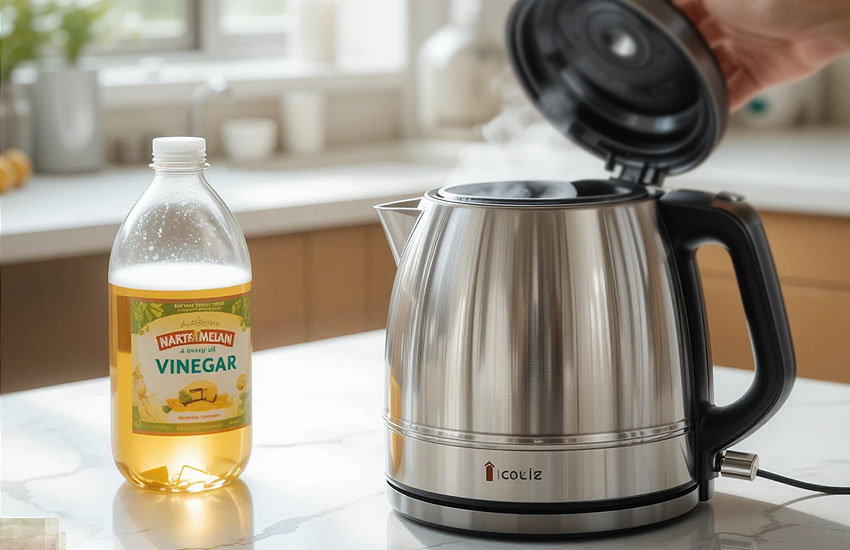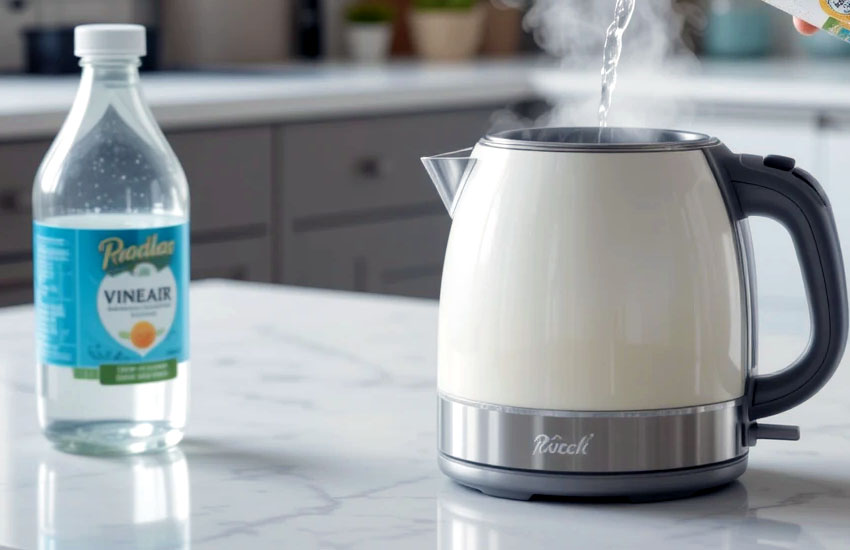Do you love your electric kettle but find that it's looking a bit grimy lately? The mineral buildup from hard water and regular use can make it look less than inviting. Don't worry though! In this guide, we'll show you how to clean your electric kettle using vinegar—a simple, natural, and super effective way to restore its shine. Stick with us, and in just a few easy steps, you'll have your kettle sparkling clean and ready for your next cup of tea or coffee. You won't believe how simple it is to get your kettle looking brand new again!

Why Clean Your Electric Kettle with Vinegar?
Before diving into the cleaning process, let's talk about why using vinegar is such a fantastic idea. You might be wondering, "Why vinegar?" Well, vinegar is a natural cleaner that has been used for centuries to clean everything from countertops to clothes. When it comes to cleaning an electric kettle, vinegar works wonders because it's acidic, which allows it to break down mineral deposits and limescale that naturally build up from regular use.
Electric kettles, especially those in areas with hard water, are prone to limescale accumulation. This buildup can interfere with the kettle's performance, making it take longer to boil water or even affect the taste of your drinks. But with vinegar, you can get rid of all those unwanted mineral deposits, bacteria, and grime without harsh chemicals. And don't worry—once you've rinsed your kettle, any lingering vinegar smell will quickly vanish, leaving behind a clean and fresh kettle.
Now, let's get into the steps to make your electric kettle shine again using just vinegar.
Step-by-Step Guide to Cleaning Your Electric Kettle with Vinegar
Cleaning your electric kettle with vinegar is easy, cost-effective, and doesn't require any special equipment. Whether you've got limescale buildup or just want to freshen up your kettle, following these simple steps will leave you with a sparkling clean appliance in no time. So grab some vinegar, and let's dive in!
1. Gather Your Supplies
Before you get started, make sure you have everything you need. The great thing about cleaning your electric kettle with vinegar is that it's super simple, so you won't need a long list of fancy supplies.
Here's what you'll need:
- White vinegar (you can also use apple cider vinegar, but white vinegar works best for this task)
- Water (preferably filtered for best results)
- A soft sponge or cloth for wiping
- Baking soda (optional, for extra cleaning power)
- A towel or paper towel for drying
If your kettle has a removable filter or is made of stainless steel, you might want to check for any additional cleaning tips in the manufacturer's guide.
2. Fill the Kettle with Vinegar Solution
Now that you've got your supplies ready, it's time to fill your electric kettle with a vinegar solution. The goal is to create a mixture that will help dissolve the minerals and limescale inside. Here's how you do it:
- Pour equal parts of white vinegar and water into the kettle. The exact amount will depend on the size of your kettle. For instance, if your kettle holds 1 liter of water, fill it halfway with vinegar and the other half with water.
- If your kettle has significant buildup, you can increase the vinegar concentration to 75% vinegar and 25% water. This stronger solution will help break down tough deposits faster.
3. Boil the Vinegar Solution
Once your kettle is filled with the vinegar-water solution, plug it in and turn it on to bring it to a boil. Let it boil for a few minutes to allow the vinegar to work its magic on the limescale.
When the water reaches a rolling boil, turn off the kettle and let it sit for 10 to 15 minutes. This will give the vinegar solution time to loosen the limescale and any other buildup inside. Don't worry about the vinegar smell—it's temporary and will disappear once the kettle is properly rinsed.
4. Scrub Away the Build-Up
After the vinegar solution has had time to work its magic, it's time to tackle any leftover limescale. If your kettle has a lot of buildup, you may notice some of the deposits floating in the water. You can take a soft sponge or cloth to gently scrub the inside of the kettle, focusing on areas where the limescale is most noticeable.
If you have a stainless steel kettle, avoid using harsh scrubbers like steel wool that could scratch the surface. Instead, stick to a soft sponge or cloth, and use a little extra vinegar if needed.
For stubborn spots, sprinkle a small amount of baking soda directly onto the limescale, then scrub gently. The baking soda acts as a mild abrasive that can help lift stubborn stains and deposits.
5. Rinse the Kettle Thoroughly
Once you've scrubbed away the limescale and grime, it's time to rinse your kettle. Dump out the vinegar solution, and rinse the inside of the kettle with warm water to remove any remaining vinegar.
Make sure to give it a good rinse so that there's no lingering vinegar smell. It's best to repeat the rinse process a couple of times until the water runs clear and clean.
If your kettle has a removable filter, don't forget to rinse that as well! You can soak the filter in a bowl of vinegar solution for a few minutes to clean it more thoroughly.
6. Dry the Kettle and Exterior
Now that your electric kettle is clean on the inside, it's time to dry it off. Use a soft towel or paper towel to wipe down the interior, removing any remaining moisture. You should also dry the exterior of the kettle to keep it looking pristine.
If there's any limescale buildup around the spout or on the outside, you can also use the vinegar solution to clean the exterior with a soft cloth. Just make sure to wipe it off with a dry cloth afterward to prevent water spots.
7. Enjoy Your Freshly Cleaned Kettle
With all the cleaning done, your electric kettle is now fresh, clean, and ready for use! Fill it up with fresh water, turn it on, and enjoy your next hot beverage without the worry of any strange odors or mineral flavors.
Regularly cleaning your kettle with vinegar not only keeps it looking great but also helps extend its lifespan. Plus, it ensures that your hot water tastes clean and fresh every time.
How Often Should You Clean Your Electric Kettle with Vinegar?
Now that you know how to clean your electric kettle, you might be wondering how often you should be doing it. The answer really depends on how often you use your kettle and the quality of the water in your area.
- If you have hard water: You'll want to clean your electric kettle every few weeks, as hard water can cause significant limescale buildup over time. Using vinegar regularly will help prevent this buildup from becoming a major problem.
- If you use your kettle daily: Even if your water isn't particularly hard, regular cleaning every month or so will keep your kettle in tip-top shape and ensure that it operates efficiently.
- If you only use your kettle occasionally: If you don't use your electric kettle very often, cleaning it once every 2-3 months should be sufficient.
Regardless of how often you clean your kettle, using vinegar is an easy and affordable way to maintain it, ensuring it stays clean and functional.
I hope this guide has helped you see just how easy it is to clean your electric kettle using vinegar. Whether you have hard water buildup or simply want to keep your kettle in good working condition, vinegar is an affordable and effective solution. Remember to clean your kettle regularly to ensure it stays in top shape and provides you with clean, tasty water for all your hot beverages. Enjoy your fresh, shiny kettle!

Frequently Asked Questions
Is it safe to clean an electric kettle with vinegar?
Yes, it is safe to clean an electric kettle with vinegar. Vinegar is a natural cleaner that is effective at removing limescale and mineral buildup without damaging the kettle.
Can I use apple cider vinegar instead of white vinegar?
Yes, apple cider vinegar can be used as an alternative to white vinegar, though white vinegar is often preferred due to its stronger acidity.
Do I need to dilute the vinegar before using it in the kettle?
Yes, you should dilute vinegar with water to prevent any damage to the kettle. A 1:1 ratio of vinegar to water is ideal for most kettles.
Is it safe to boil vinegar in an electric kettle?
Yes, it is safe to boil vinegar in an electric kettle. It helps break down mineral buildup and cleans the interior effectively.
Can I use baking soda to clean my electric kettle?
Yes, baking soda can be used to scrub away stubborn limescale or stains, especially when mixed with vinegar.
Do I need to scrub the kettle after boiling the vinegar solution?
Scrubbing may be necessary for heavy limescale buildup, but a light rinse and soak will usually do the trick.
Is it necessary to clean the filter of my kettle?
Yes, the filter should be cleaned regularly to ensure optimal performance and clean water. You can soak it in a vinegar solution for a few minutes and rinse it thoroughly.
Can I use other cleaning agents to clean my electric kettle?
While vinegar is highly effective, you can also use specialized kettle cleaning products if needed. However, vinegar is the most natural and cost-effective option.